Last Updated on January 3, 2024 by Greg Gillson
I’ve put this resource together for you to answer your question: What birds are in my backyard in New York?
This article lists and discusses the identification of the most common birds in your backyard. The birds chosen in this article are compiled from actual data from the citizen science program eBird. Thus, it is more accurate than some other similar articles you may find on the web. I provide pictures of each bird species mentioned. I tell how to attract them to your backyard.
These are the most common backyard birds in New York State:
- Blue Jay
- American Robin
- Northern Cardinal
- American Crow
- Black-capped Chickadee
- Mourning Dove
- American Goldfinch
- European Starling
- Song Sparrow
- Downy Woodpecker
- Red-winged Blackbird
- House Sparrow
- Common Grackle
- Red-bellied Woodpecker
- White-breasted Nuthatch
- Tufted Titmouse
- Dark-eyed Junco
- Gray Catbird
- White-throated Sparrow
- Northern Flicker
- House Finch
- Rock Pigeon
- Cedar Waxwing
- Barn Swallow
- Chipping Sparrow
- House Wren
New York Birds and Birding in New York State
eBird lists over 510 types of birds as occurring in the state of New York.
The most common bird in New York: the most frequently seen bird in the state is Blue Jay. It is reported on 44% of bird watching lists.
The official State Bird of New York is the Eastern Bluebird.
If you are serious about knowing the birds native to New York, then check out eBird for New York. It has recent sightings and photos, illustrated checklists with weekly abundance bar charts for state, counties, and individual hotspots of the best birding locations.
If you want to know about other people interested in birds in your area, join a local bird group. The American Birding Association maintains a list of bird watching clubs for each state.
New York Bird Identification
This section is designed to help you to recognize birds you see in your backyard. I have used eBird to select the birds that are most common.
“Common” means the birds seen most often throughout the year, not necessarily the most numerous.
In the identification section I am using size and shape and bill type before considering the color or patterns on the birds. I find these more reliable when trying to identify an unknown bird. Pay attention to body and tail shape and especially bill shape of birds you see, not just plumage color.
In the section on bird feeders and foods I tell how to attract each species. Not all types of backyard birds will come to feeders. But all backyard birds can be attracted with water. So don’t forget to add a birdbath to your bird feeding station.
1. Blue Jay (Cyanocitta cristata)
A common and well-known backyard bird in the eastern half of the United States.
 |
| Blue Jay. skeeze from Pixabay |
Range: Blue Jays are year-round residents throughout New York.
Identification:
Size: About that of American Robin.
Shape: Fluffy, large crested head, ample tail. Large strong legs.
Bill: Black, long and stout.
Color: Blue above, white below. Black neck collar. White patches in wing.
Habitat, range & behavior: Woodlands and towns in the eastern half of the United States.
In summer into southern Canada. They are bold and brash. May bully smaller birds. Jays gulp lots of seeds or other food at once, storing it in their crop. Then they fly off and bury food items in a hidden cache.
Food and feeder preference: Diet: Omnivorous. They can quickly empty your feeder! Because they are also aggressive toward other feeder birds, some people put mesh cages around smaller bird feeders. Small birds can go through, squirrels and larger “pest” birds are prevented entry. Some people feed jays peanuts, perhaps away from the seed feeders.
2. American Robin (Turdus migratorius)
This familiar backyard bird is a resident in the northern half of the United States and a common winter visitor in the southern half.
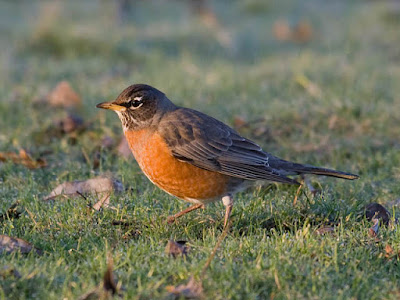 |
| American Robin. Greg Gillson |
Range: American Robins are a summer resident in the northeastern portion of New York, a year-round resident in the rest of the state.
Identification: This is a key species for comparing with an unknown bird.
Size: 10 inches long from bill tip to tail tip. About the same size as a Blue Jay or one of the Scrub-Jays. Larger than Red-winged Blackbird. Smaller than a Mourning Dove.
Shape: Very plump with a fairly long tail.
Bill: Straight and fairly slender, curved at the tip.
Color: Gray-brown upperparts, rusty orange breast.
Habitat, range & behavior: Open woodlands, farmlands, urban parks and lawns.
It is migratory, breeds north across Alaska and Canada. Resident in most of the United States (lower 48). Winters in the United States, Mexico, to central America.
Hops on your lawn turning head this way and that looking for food. Their caroling song is one of the early signs of spring in the north.
Food and feeder preference: Worms and other invertebrates in the lawn are their main diet. May eat fruit from a tray feeder or the ground. Eat small berries from trees and bushes.
3. Northern Cardinal (Cardinalis cardinalis)
This is one of the most common and popular backyard birds in the eastern half of the United States.
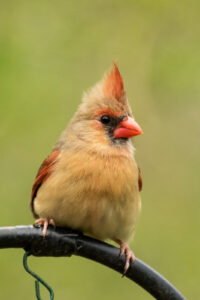
Range: Northern Cardinals are year-round residents throughout New York except they are absent in mountains in the northeastern corner of the state.
Identification:
Size: Cardinals are a bit smaller than American Robins, about the same size as Red-winged Blackbirds.
Shape: Plump body with fairly long full tail. Wispy crest.
Bill: Short, heavy, conical, pink.
Color: That bright red color is matched by few other birds. Black face. The female is grayer, but with hints of red in wings and tail, and has a crest, too.
Habitat, range & behavior: Cardinals are year-round residents in shrubby woodland edges from the eastern United States to Texas and Arizona south into Mexico.
That large conical bill is made for chewing seeds. Watch them crack open sunflower seeds, spit out the hulls, and pluck the kernel with their tongues!
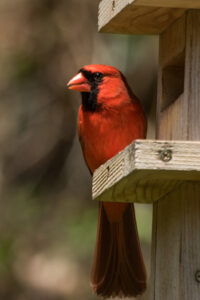
Food and feeder preference: Attract with black oil sunflower seeds. Their diet includes many types of seeds, berries, nuts in larger hopper or tray feeders.
You may like my in-depth article on attracting Northern Cardinals.
4. American Crow (Corvus brachyrhynchos)
This larger all-black bird is common in cities and country. Its cawing call is familiar to most people.
 |
| American Crow. Greg Gillson |
Range: American Crows are year-round residents throughout New York.
Identification: This is a key species for comparing with an unknown bird.
Size: About 17-1/2 inches long from bill tip to tail tip, though there is much size variation throughout its range. Larger than blackbirds and grackles. Smaller than ravens.
Shape: Thick neck, large head, rather short square-ended tail. Longer legs. In flight has rounded wing tips with each primary feather separated from others forming “fingers.”
Bill: As long as head, thick, black.
Color: Glossy black throughout.
Habitat, range & behavior: They prefer open areas with trees, fields, farms, cities and are common across most of the United States lower-48, except in the desert southwest. They move into southern Canada in summer.
American Crows gather in evening communal roosts in large flocks that may number into the thousands and then move out at dawn into the surrounding area.
Food and feeder preference: Omnivorous, they feed on large insects, grain, small mammals, carrion. You probably don’t want these large entirely black birds in your backyard feeders. So don’t feed table scraps to birds.
5. Black-capped Chickadee (Poecile atricapillus)
This is a common backyard bird in the northern half of the United States.
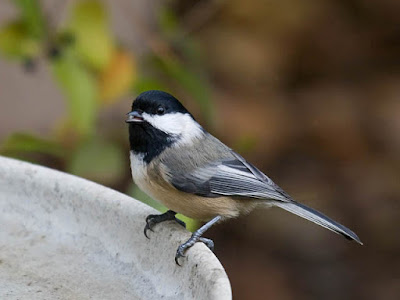 |
| Black-capped Chickadee. Greg Gillson |
Range: Black-capped Chickadees are year-round residents throughout New York.
Identification:
Size: Chickadees are small birds, the same general size as an American Goldfinch.
Shape: Round body, big round head, long tail with rounded tip.
Bill: Short, straight, stout.
Color: Gray above, buffy below. Black cap and bib with white lower face. White edges on wing feathers.
Habitat, range & behavior: Deciduous and mixed forests.
They range from the northern half of the United States, southern half of Canada, and most of Alaska.
Small flocks flit actively from tree to tree acrobatically gleaning insects from twig tips. In winter chickadees make up the core of mixed-species flocks also containing nuthatches, kinglets, creepers, woodpeckers and others.
Food and feeder preference: Seeds, insects, berries. They eat at tube, hopper and tray feeders. They love black oil sunflower seeds and suet.
You may like my in-depth article on attracting Black-capped Chickadees.
6. Mourning Dove (Zenaida macroura)
Mourning Doves are the most widespread and most frequent backyard bird in the Lower 48 states of the United States.
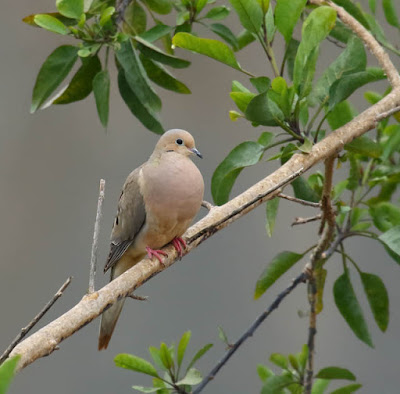 |
| Mourning Dove. Greg Gillson |
Range: Mourning Doves are year-round residents throughout New York except summer residents only in the mountains of the northeastern part of the state.
Identification: This is a key species for comparing with an unknown bird.
Size: About 12 inches long from bill tip to tail tip. About same size as Northern Flicker. Larger than American Robin. Slightly smaller than domestic city pigeon.
Shape: Very plump with a small round head. Tail is long and pointed. Legs are short.
Bill: Small and rather slender.
Color: Pale brown-pink body, darker wings and tail. White edges on side of tail.
Habitat, range & behavior: Semi-open areas such as urban areas, farmlands, woods. Often seen perched on wires, fences. It is a resident across the lower-48 states and Mexico, with some movement out of northern areas in winter.
Their mournful cooing is a familiar spring birdsong.
Food and feeder preference: Mourning Doves eat seeds almost exclusively. Attract with black oil sunflower seeds on a large sturdy tray feeder or on the ground.
7. American Goldfinch (Spinus tristis)
A beautiful tiny finch familiar to many in its bright yellow summer plumage. Colloquially called a “wild canary.”
 |
| American Goldfinch. Greg Gillson |
Range: American Goldfinches are year-round residents in New York.
Identification: This is a key species for comparing with an unknown bird.
Size: Very small at about 5 inches from bill tip to tail tip. Similar in size to a chickadee. Larger than hummingbirds. Smaller than juncos and House Finches.
Shape: Tiny, somewhat plump with larger head and short tail.
Bill: Short, conical, pink.
Color: Males in summer are bright lemon yellow with black forehead and black wings and tail with white bars. White under tail coverts. Females are dull olive, wings and tail browner. Winter birds are pale grayish-yellow with tan and brown wings and tail.
Habitat, range & behavior: This species is found in weedy fields and similar clearings with thistles and similar plants.
It is found coast-to-coast throughout the year across most of the middle lower-48 states. In summer moves north to the Canada border. In the winter found south to the Mexico border.
The flight is highly undulating, rising and falling as they flap in short bursts.
Besides a long, sweet lilting song, they call in flight a lilting 4-part: “potato chip!”
Food and feeder preference: Feeds on weed seeds, thistle seed. May eat black oil sunflower seeds from tube feeder. Attract with Niger seed in a feeder called a “thistle sock.”
You may like my in-depth article on attracting American Goldfinches.
8. European Starling (Sturnus vulgaris)
Introduced to North America in the late 1800’s, they crossed the continent, often to the detriment of native cavity-nesting birds. The prime example of an invasive species.
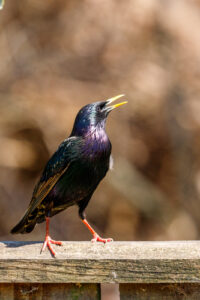 |
| European Starling. Greg Gillson |
Range: European Starlings are year-round residents throughout New York.
Identification:
Size: About the size of a Red-winged Blackbird. Smaller than an American Robin. Larger than a White-crowned Sparrow or Spotted/Eastern towhee.
Shape: Stocky with large head, short square-ended tail. Longer legs.
Bill: As long as head. Sharp pointed. Yellow in spring, otherwise dark.
Color: They are grayish brown much of the year, with glossy iridescence and white spotting during the spring.
Habitat, range & behavior: Lowland birds that need trees large enough for nest cavities but plenty of open area for feeding.
They are most abundant in urban and suburban areas where they find food and artificial nest cavities.
Resident from coast-to-coast from southern Canada to northern Mexico. In summer north across Canada and Alaska. Native range is Europe to Pakistan, north Africa.
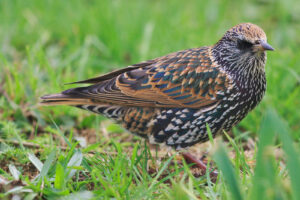
Often viewed as a pest, starlings often bully other backyard birds, taking over bird feeders, and stealing nest cavities from smaller native birds. In winter they can form into flocks of tens of thousands.
Food and feeder preference: Primarily insects when available, often feeding on the ground. Discourage them from your backyard hopper and tray feeders by never feeding birds table scraps (including bread or meat). They have weak feet and do not perch well on tube feeders. A cage mesh around smaller hopper feeders may keep them out.
9. Song Sparrow (Melospiza melodia)
A common bird, but variable, and similar to many other streaked brown sparrows.
 |
| Song Sparrow. Greg Gillson |
Range: Song Sparrows are year-round residents throughout most of New York, except found in summer only in the mountainous northeastern portion of the state.
Identification:
Size: A smaller bird, similar in size to House Finch and juncos. Larger than chickadees and goldfinches. Smaller than White-crowned Sparrows or Spotted/Eastern towhees.
Shape: Plump with round head, long rounded tail.
Bill: Short, conical.
Color: Highly variable in darkness and color saturation across its range (dark rusty to pale gray). Generally gray-brown above with dark brown streaking on back. Complicated head pattern. Streaking on sides and breast converge into dense central breast spot.
Habitat, range & behavior: Thickets, especially near water. Backyard shrubbery.
Resident in western United States, western Canada, coastal southern Alaska, northeastern US. In summer also moves into mid-Canada and northern half of US. In the winter found in most of the US lower-48. Also, a population in central Mexico.
Forages on ground, never far from low cover to which they fly if startled.
Food and feeder preference: They feed on seeds and insects near the ground. Will visit hopper and tray feeders for mixed bird seed.
10. Downy Woodpecker (Dryobates pubescens)
This tiny woodpecker is found in backyards across the United States.
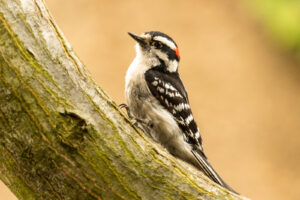 |
Range: Downy Woodpeckers are year-round residents in New York.
Identification:
Size: Bigger than a junco or House Finch. Smaller than a Red-winged Blackbird. About the same size as a White-crowned Sparrow, but with a much shorter tail.
Shape: Stocky with large head and short stiff tail.
Bill: Short, chisel shaped.
Color: Black-and-white striped head. Black wings with white spots. Solid white back. White under parts. Black tail with white outer tail feathers with black bars or spots. Male with small red spot at back of head.
Habitat, range & behavior: Found in small deciduous trees, willows, and even weed stocks such as teasel, especially near water.
Ranges coast-to-coast across all but northernmost parts of Canada and Alaska south to the southern US. Absent in the desert southwest.
Interestingly, I learned today that the males may more often be found in smaller plants and twigs, while females are more likely on tree trunks.
Food and feeder preference: Insects, fruits, and seeds. Gleans arthropods from the bark of trees. Attract with suet feeder. Will also eat black oil sunflower seeds.
11. Red-winged Blackbird (Agelaius phoeniceus)
These noisy flocking birds are most often found in marshes. But in winter they are found in backyards.
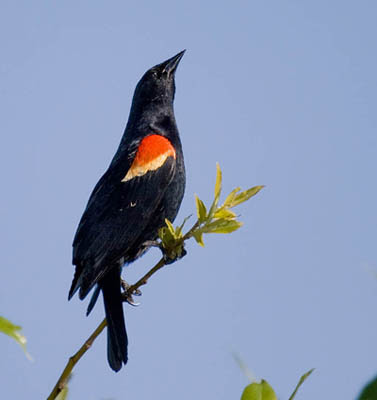 |
| Male Red-winged Blackbird. Greg Gillson. |
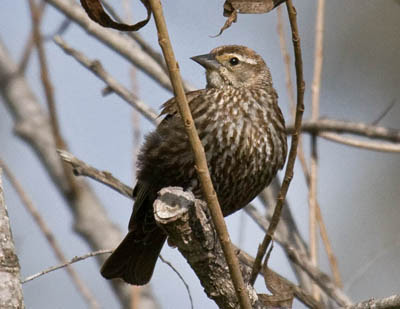 |
| Female Red-winged Blackbird. Greg Gillson. |
Range: Red-winged Blackbirds are year-round residents throughout New York.
Identification: This is a key species for comparing with an unknown bird.
Size: About 8-3/4 inches long from bill tip to tail tip. About the size of a Northern Cardinal. Smaller than an American Robin.
Shape: Pot-bellied with a longer bill and flat forehead. Tail average.
Bill: Long and sharp pointed.
Color: Males are black with red and yellow shoulder patch. Females are streaked brown and rusty (sparrow-like but pointed bill and flat forehead).
Habitat, range, and behavior: Cattail marshes and wetlands are their summer habitat. In winter they feed in grain fields.
They breed across most of the North American continent. In winter they withdraw from most of Alaska and Canada.
They are found in colonies in summer and large flocks in winter.
Food and feeder preference: They eat insects in summer. In winter they eat grain and seeds. They visit feeders, more often in large winter flocks, and eat most seeds and suet.
12. House Sparrow (Passer domesticus)
Like the starling, this is another bird introduced from Europe in the 1800’s. This sparrow is commonly found in cities and farmlands. It is considered a pest in most areas where it has been introduced.
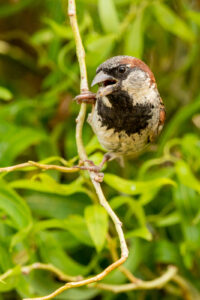 |
Range: House Sparrows are year-round residents throughout New York.
Identification:
Size: The size of a House Finch or Dark-eyed Junco.
Shape: Chunkier than native North American sparrows with large head, barrel chest, short neck, medium tail, short legs.
Bill: Short, conical.
Color: Males are brown and gray with a black mask. Females lack the black and are tan and brown with a pale line back from the eye.
Habitat, range & behavior: Cities and farms.
Range in North American from southern Canada through Central America. In summer northward through Canada to southern Alaska. Originated in Middle East and spread to most of Europe and Asia. Introduced in South America, Africa, Australia–nearly anywhere there are people and cities.
They tend to be messy… and have a good appetite and may occur in large noisy chirping flocks. They are aggressive toward other feeder birds.
Food and feeder preference: They eat grain, seed, and insects. To discourage them from your hopper and tray feeders do not feed birds human food scraps. They have a bit of difficulty eating from tube feeders.
13. Common Grackle (Quiscalus quiscula)
Sometimes considered a pest to crops, grackles are longer and lankier than very similar blackbirds.
 |
| Common Grackle. GeorgiaLens from Pixabay |
Range: Common Grackles are year-round residents across southern New York, summer residents only in the northeastern mountains.
Identification:
Size: Larger than Red-winged Blackbirds, they are near the length of Mourning Doves.
Shape: Long, with long full keel-shaped tail, long legs, flat crown.
Bill: Longer than head, pointed, but stouter than other blackbirds.
Color: Glossy black with hint of bronze or green on head (depending upon population). Yellow eye.
Habitat, range & behavior: They are found in agricultural areas, woodland edges, city parks and lawns. Resident in the southeastern United States. In summer they migrate northward and west to the central United States and Canada.
They monopolize feeders and are bullies toward other birds.
Food and feeder preference: Grain, corn, acorns, small aquatic fish and amphibians. To discourage them, use tube feeders, rather than hopper or tray feeders. Don’t over-feed, keep spilled seed picked up.
14. Red-bellied Woodpecker (Melanerpes carolinus)
This is one of the most common backyard species in the eastern half of the United States.
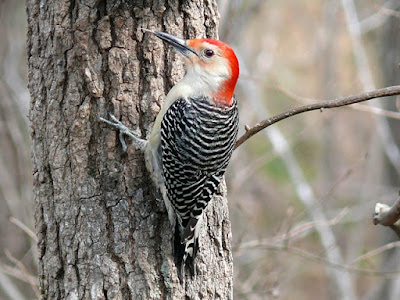 |
| Red-bellied Woodpecker. skeeze from Pixabay |
Range: Red-bellied Woodpeckers are year-round residents in most of New York except absent in the northeastern mountains.
Identification:
Size: Fairly large for a backyard bird. Between a Starling and American Robin in size. Smaller than a Northern Flicker.
Shape: Stout with large head and short tail. Clings to tree trunk on strong short legs propped up with short stiff tail.
Bill: Long, chisel shaped.
Color: Pale gray body, many thin black-and-white bars across back and wings. Red nape, extending forward on crown on male.
Habitat, range & behavior: These birds are found in many woodland types, including oak, hickory and pine.
They are found from the eastern slope of the Rocky Mountains in the lower-48 states from Texas to extreme southern Canada, and eastward from Florida northward just to the southern edge of the New England states.
In typical woodpecker fashion, it hitches up the tree trunk and larger branches.
Food and feeder preference: This species eats a diet of insects and nuts. They may eat peanuts from a tray feeder and eat from a suet block.
15. White-breasted Nuthatch (Sitta carolinensis)
 |
| White-breasted Nuthatch. Greg Gillson |
Range: White-breasted Nuthatches are year-round residents throughout New York.
Identification:
Size: About chickadee-sized in length. Smaller than a junco or House Finch.
Shape: Appears large-headed, neckless, very short tailed. Short legs.
Bill: Nearly as long as head, straight, thin.
Color: Blue-gray above, white below. Black cap, wing tips, tail. Rusty feathers under tail.
Habitat, range & behavior: Common in oak and oak-pine woodlands, wooded towns. Found across the United States, southern Canada, mountains of central Mexico. Absent from treeless grasslands, deserts in the west.
Crawls over tree branches and head-first down tree trunks searching for insects.
Food and feeder preference: Their diet includes insects, seeds, acorns and other nuts. Attract with black oil sunflower seeds feeding on hopper and tray feeders. Suet blocks.
16. Tufted Titmouse (Baeolophus bicolor)
Related to chickadees, they lack the black bib, but have a crest instead.
 |
| Tufted Titmouse. anne773 from Pixabay |
Range: Tufted Titmice are year-round residents in New York, except absent in mountains of northeastern part of state.
Identification:
Size: A small bird, but a large titmouse, this species is larger than chickadees, about the size of a junco or House Finch.
Shape: Rounded body, long full tail, big head, long legs.
Bill: Short and stout, compressed (taller than wide), black.
Color: Dark blue-gray above, pale below. Black feathers around eye accentuates its size.
Habitat, range & behavior: Lives in deciduous forests with heavy canopy, parks.
Found in eastern and southeastern United States is expanding its range north and west.
Food and feeder preference: Insects and seeds. At your hopper or tray feeder attract with black oil sunflower seeds and suet.
17. Dark-eyed Junco (Junco hyemalis)
Colloquially called “snowbirds,” they often arrive in backyards in winter from nearby mountain forests or more northern climes.
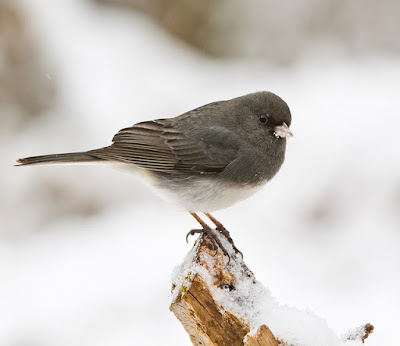 |
| Dark-eyed Junco. skeeze from Pixabay |
Range: Dark-eyed Juncos are year-round residents throughout most of New York. They are winter visitors only in the New York city area.
Identification:
Size: Small birds about the size of a House Finch.
Shape: Round body, short neck, round head, fairly long square-ended tail.
Bill: Short, pointed, conical, pink.
Color: Eastern birds are a darker all-gray with white belly. Western birds have jet black hood over the head, brown back, and pink sides; females paler.
Habitat, range & behavior: Breed in coniferous forests. Avoids heavy brush, preferring widely spaced bushes.
Breeds in summer in Alaska and across Canada, in mountains of northeastern US, widely in the West in mountains and conifer forests.
Flashes white outer tail feathers as it feeds on the ground.
Food and feeder preference: Eats mostly seeds, also insects in summer. Readily feed at backyard feeders on mixed seeds on hopper or tray feeders and ground.
You may like my in-depth article on attracting Dark-eyed Juncos.
18. Gray Catbird (Dumatella carolinensis)
This bird is rather common where it occurs, but a bit secretive.
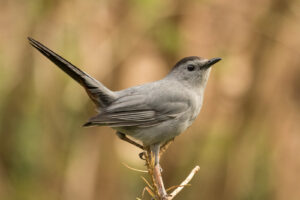 |
Range: Gray Catbirds are summer residents in New York, absent in winter.
Identification:
Size: About the length of a Red-winged Blackbird or Northern Cardinal.
Shape: Long tailed, round head.
Bill: Medium length, pointed.
Color: Gray with a black tail and black cap. Rusty under tail coverts.
Habitat, range & behavior: Dense woodland edges, scrub, abandoned orchards. Breeds in eastern and central US and adjoining southern Canada. Winters in extreme south US Gulf states, southward in eastern Mexico to Panama.
They spend much time hopping on the ground or in low bushes. They defend a winter territory, unlike most birds.
Food and feeder preference: Insects and berries. You may attract this species with jelly and fruit feeders, suet, and water.
19. White-throated Sparrow (Zonotrichia albicollis)
A fairly common bird of northern forests that visits backyards across much of the US.
 |
| White-throated Sparrow. Greg Gillson |
Range: White-throated Sparrows are year-round residents throughout much of New York. They are found only in summer in the northern mountains. They are found only in the winter in the New York city area and also in the western parts of the state.
Identification:
Size: Similar in size to White-crowned Sparrow. Bigger than a House Finch; smaller than a starling.
Shape: Longer body. Round head on short neck. Long tail with notched tip.
Bill: Short. conical.
Color: Striped tan and brown above, pale gray below. White-striped form with black and white head stripes. Tan-striped form with tan and brown striped head. First year birds are similar to tan-stiped adults, but streakier overall. Yellow spot between eyebrow and bill. White throat strongly offset from gray breast and face.
Habitat, range & behavior: Found in forests, brush, and open woodland edges.
Breeds across Canada and northernmost Eastern United States. Winters in the eastern US, southern central US, and rare but regular along the West Coast.
Found in small flocks on ground near brush into which they can flee. Kick up leaves to search under for food.
Food and feeder preference: Eat seeds and berries in winter, more insects and fruit in summer. In your feeder will eat mixed seeds on a platform feeder and on the ground.
20. Northern Flicker (Colaptes auratus)
Of all the bird identification questions I get asked, this common larger backyard bird is the bird most people ask about. It doesn’t occur to those unfamiliar with it that this could be a woodpecker.
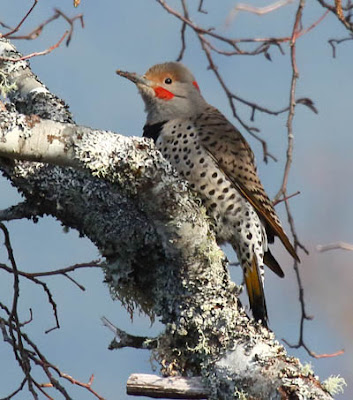 |
| Northern Flicker. Greg Gillson. |
Range: Northern Flickers are year-round residents throughout most of New York. However, they are only found in summer in the northern mountains.
Identification:
Size: About the size of a Mourning Dove. Larger than a robin.
Shape: Stocky with short legs, short tail, big head.
Bill: As long as head, thin, slightly curved.
Color: Back is brown with black bars. Under parts pinkish with black spots. Undersides of black wing and tail feathers are bright salmon red (West) or yellow (East). Head gray (West) or brown (East) and males with red (West) or black (East) whisker marks and nape marks (East). Black crescent across chest. White rump seen in flight.
Habitat, range & behavior: Found in woodland edges and forests.
Year-round resident from extreme southern Canada, across all of the lower-48 states and in the mountains of Mexico and Middle America. In summer breeds northward well into Canada and Alaska.
Frequently noted hopping on ground pecking in the ground for insects. In late spring, males proclaim their territory by rapid pounding on a hollow tree branch, though the ringing of metal downspouts at dawn is louder and carries much farther, to the exasperation of anyone trying to sleep inside!
Food and feeder preference: Ants and beetles are their primary foods. Will eat black oil sunflower seeds and are attracted to suet.
21. House Finch (Haemorhous mexicanus)
These are one of the United States’ most common backyard birds. There are other red finches, but these are the ones most likely in residential areas.
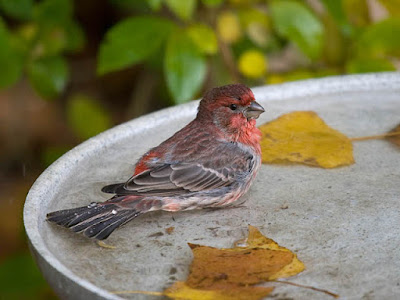 |
| House Finch. Greg Gillson. |
Range: House Finches are year-round residents throughout New York.
Identification: This is a key species for comparing with an unknown bird.
Size: About 6 inches from bill tip to tail tip. Larger than goldfinches and chickadees. Smaller than a White-crowned Sparrows or Spotted/Eastern towhees.
Shape: Medium build with a medium-long notched tail. Round head.
Bill: Short, conical.
Color: Brown and gray above with streaks on the sides of the pale underparts. Males with red (sometimes orange or rarely yellow) crown, chest, rump.
Habitat, range & behavior: You’ll find small flocks on wires, in short treetops and in bushes. Originally deserts and grasslands. Rural areas and towns are where they’re now most common.
Formerly found in the western United States and Mexico. Then introduced into the northeastern United States, but now found in nearly all of the lower-48 states and extreme southern Canada. Rare in plains states (Dakotas to Texas) and southern Florida.
House Finches are not territorial, but males sing throughout the year–a lively, wiry song ending in a couple of buzzy notes.
Food and feeder preference: House Finches love sunflower seeds. Attract them with these seeds in tube feeders. May eat from thistle socks.
You may like my in-depth article on attracting House Finches.
22. Rock Pigeon (Columba livia)
These pigeons are especially common in urban settings. They are also known as Rock Doves or domestic pigeons.
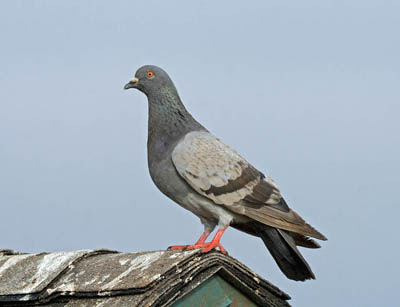 |
| Rock Pigeon. Greg Gillson. |
Range: Rock Pigeons are year-round residents throughout New York.
Identification:
Size: Larger than a Mourning Dove.
Shape: Large chest. Small round head. Pointed wings. Squared tail.
Bill: Short and fairly thin, with bump on nostril.
Color: Variable; may be white, rusty, or pied. “Wild” coloration has a blue-gray body with iridescent sheen on throat. Paler gray wings with two dark broad wing bars. Tail with dark band. White rump.
Habitat, range, & behavior: City streets, building ledges, and commercial parking lots; farms.
Resident across Canada, all of the United States, south into Mexico. Worldwide distribution.
Often seen perched on roofs and ledges in cities. Walk on sidewalks picking up scraps of food garbage dropped by humans.
Food and feeder preference: Eat grain and corn, and human food scraps, especially French fries and other fast-food garbage. May eat just about any food at platform and larger hopper feeders.
23. Cedar Waxwing (Bombycilla cedrorum)
Waxy red tips to the wing feathers give these backyard birds their unique name. Maybe it’s the fancy crest. Maybe it’s the bandit mask. Maybe it’s the yellow band at the tip of its tail. But these are one of my favorite birds.
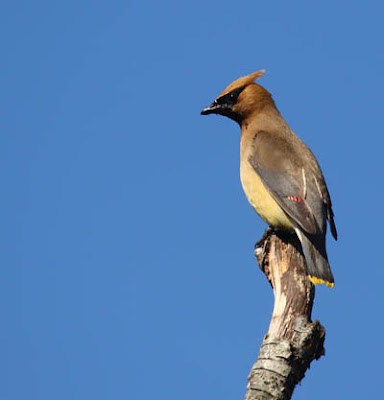 |
| Cedar Waxwing. Greg Gillson. |
Range: Cedar Waxwings are year-round residents throughout New York.
Identification:
Size: Smaller than European Starling. Larger than House Sparrow.
Shape: Similar to European Starling. Rather stocky. Short squared tail, but long under tail coverts. Large head. Pointed wings. Wispy crest.
Bill: Rather short, small, wide.
Color: Warm brown above with wispy crest. Black mask. Yellowish belly. White under tail coverts. Gray wings. Gray tail with yellow tip.
Habitat, range, & behavior: Deciduous woods, wooded streams and lakeshores, residential shade trees, fruit orchards.
Resident across the northern US. Summer resident in Canada. Winter visitor throughout all of US and Mexico.
Keep in tight flocks. Feed in trees and large bushes for berries. Fly catch over ponds and streams.
Food and feeder preference: Berries and flying insects. Usually don’t come to feeders unless fruit like cherries offered but will visit bird baths.
24. Barn Swallow (Hirundo rustica)
These common swallows are widely distributed throughout the world, primarily breeding in the northern hemisphere, and wintering in the mid-latitudes and southern hemisphere.
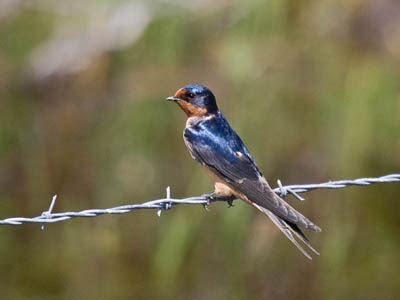 |
| Barn Swallow. Greg Gillson. |
Range: Barn Swallows are summer residents throughout New York.
Identification:
Size: About the size of a House Finch but with a much longer tail.
Shape: Stocky, short necked but with long body and tail. Tail is forked, with very long outer tail feathers. Wings pointed.
Bill: Short, wide.
Color: Glossy dark purplish-blue above. Pinkish-orange below.
Habitat, range & behavior: Barn Swallows live in open country, frequently near humans. Farmlands. Nest in barns, under small bridges.
In North America breed from Mexico to northern Canada and Alaska, wintering from southern Mexico throughout most of South America.
Frequently seen swooping low over the ground hunting flying insects. Perch on wires, fences. Voice is twitters and chirps with grating sounds.
Food and feeder preference: Eat flying insects on the wing and are not attracted to backyard feeders.
25. Chipping Sparrow (Spizella passerina)
Chipping Sparrows are a widespread species adapted to human disturbance. They are rather tame. They are frequently found in cemeteries with large trees.
 |
| Chipping Sparrow. Greg Gillson. |
Range: Chipping Sparrows are summer residents throughout New York.
Identification:
Size: These are small sparrows, bigger than goldfinches or chickadees, but smaller than House Finches or Song Sparrows.
Shape: Plump and fairly long tailed.
Bill: Short and conical.
Color: Striped brown and dark brown above. Grayish under parts. Black line through eye. Crown streaked in winter but in summer becomes solid chestnut. Two white wing bars.
Habitat, range & behavior: Grassy open conifer woodlands with some shrubs, parks, orchards.
Breeds from Alaska, across Canada and south into highlands of Middle America. In winter retreats from northern areas to southern United States and northern Mexico.
In summer solitary or in pairs. In winter they forage in flocks of up to 50 birds.
Food and feeder preference: Weed seeds, supplemented with insects in summer. They may eat black oil sunflower seeds in your feeder, but more likely will feed on mixed seeds on the ground under the feeder.
26. House Wren (Troglodytes aedon)
These birds will readily use backyard nest boxes to raise their young.
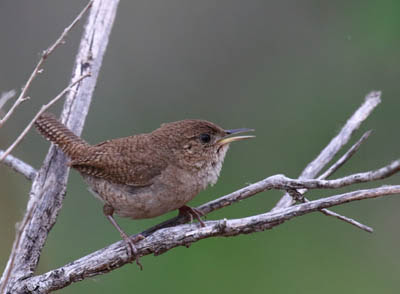 |
| House Wren. Greg Gillson. |
Range: House Wrens are summer residents throughout New York.
Identification:
Size: About the size of Black-capped Chickadee but with shorter tail.
Shape: Round body. Large head. Thin short tail.
Bill: Fairly long, thin, slightly down curved. Sharply pointed.
Color: Rather dull brownish-gray throughout. Paler throat and breast. Tail barred with black and pale bars along with the brown.
Habitat, range & behavior: Brushy areas, woodland edges, hedge rows, tree stumps in logged areas.
Breed across Canada and the northern and mid-latitudes of the United States. Winter to the southern United States and through Mexico. Found year round at southern edge of breeding range: California, North Carolina to northern Alabama, southern Arizona south through mountains of Mexico.
Stay hidden in brushy areas. Hop among tree roots, logged stumps.
Food and feeder preference: May feed at suet feeder.
Common Birds in New York
To determine how common each species is I used the data from actual bird sightings from the citizen science program eBird. Birds are listed by frequency. That is, how often the species is recorded on checklists submitted to eBird (a percentage).
I have generally excluded common waterfowl, birds of prey, shorebirds, seabirds, and others that aren’t usually found in residential areas. But they may certainly fly over or be seen regularly if your home is on a shoreline, for instance.
Most common backyard birds in New York State throughout the year
The following list is the backyard birds that are, on average, most common throughout the entire year. The list is ordered by most common based on the frequency of how often each species is recorded on checklists submitted to eBird.
- Blue Jay (42% frequency)
- American Robin (42%)
- Northern Cardinal (41%)
- American Crow (39%)
- Black-capped Chickadee (39%)
- Mourning Dove (38%)
- American Goldfinch (34%)
- European Starling (33%)
- Song Sparrow (32%)
- Downy Woodpecker (30%)
- Red-winged Blackbird (30%)
- House Sparrow (26%)
- Common Grackle (23%)
- Red-bellied Woodpecker (23%)
- White-breasted Nuthatch (23%)
- Tufted Titmouse (22%)
- Dark-eyed Junco (20%)
- Gray Catbird (20%)
- White-throated Sparrow (19%)
- Northern Flicker (17%)
- House Finch (16%)
- Rock Pigeon (15%)
Most common backyard birds in New York in winter
- Black-capped Chickadee (42% frequency)
- American Crow (37%)
- Blue Jay (36%)
- Northern Cardinal (36%)
- Downy Woodpecker (33%)
- Dark-eyed Junco (33%)
- Mourning Dove (30%)
- White-breasted Nuthatch (28%)
- European Starling (27%)
- House Sparrow (25%)
- Tufted Titmouse (25%)
- American Goldfinch (24%)
- Red-bellied Woodpecker (22%)
- White-throated Sparrow (20%)
Most common backyard birds in New York in summer
- American Robin (62% frequency)
- Red-winged Blackbird (48%)
- Song Sparrow (47%)
- Gray Catbird (45%)
- American Goldfinch (43%)
- Mourning Dove (43%)
- Northern Cardinal (40%)
- Common Grackle (38%)
- American Crow (37%)
- Blue Jay (36%)
- European Starling (33%)
- Black-capped Chickadee (31%)
- Cedar Waxwing (30%)
- Barn Swallow (29%)
- House Sparrow (27%)
- Chipping Sparrow (24%)
- Downy Woodpecker (23%)
- House Wren (21%)
Common backyard birds of Manhattan and New York City
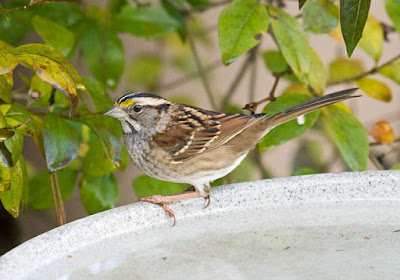 |
| White-throated Sparrow. Greg Gillson |
The backyard birds in New York City are pretty much the same for Brooklyn, Manhattan, Queens, The Bronx, and Staten Island. It is similar anywhere on Long Island.
I decided to use the backyard birds of Manhattan as representative of New York City. After all, it has Central Park.
The following list uses eBird data to compare the birds of Manhattan with the birds of the state as a whole. Manhattan is in New York County. I will use eBird data for New York County to represent the birds in the Manhattan area.
Here are the most common backyard birds throughout the year in Manhattan:
- House Sparrow (77% frequency)
- American Robin (64%)
- European Starling (64%)
- Rock Pigeon (59%)
- Blue Jay (59%)
- Northern Cardinal (52%)
- White-throated Sparrow (51%)
- Mourning Dove (48%)
- Common Grackle (41%)
- Red-bellied Woodpecker (32%)
- Gray Catbird (31%)
- Downy Woodpecker (29%)
- Song Sparrow (26%)
- Northern Flicker (24%)
- Tufted Titmouse (23%)
Three birds, here, are more common in Manhattan than the rest of the state, on average. Seeing House Sparrows top the list and adding Rock Pigeons is understandable for this highly urban area. But both White-throated Sparrows and Northern Flickers are more common than average, which is a bit of a surprise.
Less common in Manhattan than the rest of the state, on average, are American Crow (surprise!), Black-capped Chickadee, American Goldfinch, White-breasted Nuthatch and Dark-eyed Junco.
Common Backyard Birds of Rochester and Monroe County, New York
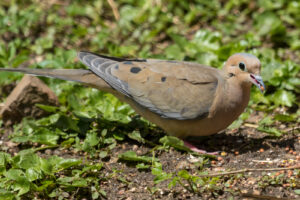
- Northern Cardinal (55% frequency)
- Blue Jay (45%)
- Black-capped Chickadee (45%)
- American Robin (44%)
- Mourning Dove (43%)
- American Goldfinch (42%)
- American Crow (40%)
- House Sparrow (40%)
- Red-bellied Woodpecker (36%)
- Downy Woodpecker (35%)
- Red-winged Blackbird (33%)
- European Starling (32%)
- Song Sparrow (27%)
- Common Grackle (25%)
- White-breasted Nuthatch (24%)
- House Finch (23%)
- Tufted Titmouse (22%)
- Dark-eyed Junco (20%)
- Northern Flicker (20%)
The common birds of Rochester match closely the common backyard birds of New York state, as a whole.
Common Backyard Birds of Buffalo and Erie County, New York
- Black-capped Chickadee (52% frequency)
- Northern Cardinal (51%)
- American Robin (46%)
- American Crow (45%)
- American Goldfinch (42%)
- Downy Woodpecker (42%)
- Blue Jay (42%)
- European Starling (42%)
- Mourning Dove (36%)
- Song Sparrow (35%)
- Red-winged Blackbird (34%)
- Red-bellied Woodpecker (31%)
- House Sparrow (27%)
- White-breasted Nuthatch (25%)
- Common Grackle (24%)
- Dark-eyed Junco (22%)
- Gray Catbird (20%)
- Northern Flicker (20%)
The list of common backyard birds in Buffalo is similar in composition and abundance to the average commonness of birds in the state of New York, on average.
However, Black-capped Chickadees and Downy Woodpeckers are a bit more common in Buffalo than in the state as a whole.
Common Backyard Birds of Albany, New York
- Blue Jay (52% frequency)
- Black-capped Chickadee (50%)
- American Crow (47%)
- American Robin (46%)
- Northern Cardinal (45%)
- Mourning Dove (44%)
- American Goldfinch (43%)
- Downy Woodpecker (38%)
- White-breasted Nuthatch (36%)
- Tufted Titmouse (34%)
- Red-bellied Woodpecker (32%)
- House Sparrow (31%)
- Song Sparrow (31%)
- Red-winged Blackbird (28%)
- European Starling (26%)
- Common Grackle (26%)
- Dark-eyed Junco (23%)
- Gray Catbird (22%)
- House Finch (21%)
- White-throated Sparrow (20%)
The common birds in backyards of Albany are similar to the state of New York, as a whole.
The only slight difference is that European Starlings are less common in Albany than in larger cities such as New York City.
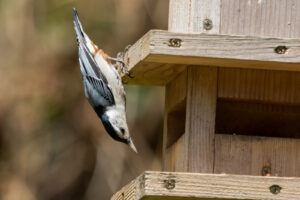
Wrapping Up
New York, both the state and the city, boasts a incredibly diverse and vibrant bird community, offering something for every bird enthusiast. I hope you have enjoyed my glimpse into the fascinating world of New York’s feathered friends.
- Over 400 species: From tiny hummingbirds to majestic hawks, New York is home to an extensive collection of bird species. This includes year-round residents, seasonal migrants, and occasional vagrants.
- Different habitats: Whether you’re in dense forests, open marshes, rocky coasts, or even bustling city parks, there’s a unique avian community to discover in each habitat.
- City slickers: New York City hosts an surprisingly rich mix of birds that have adapted to urban life. American robins, house sparrows, and mourning doves thrive in parks and green spaces, while swifts and peregrine falcons utilize skyscrapers for nesting and hunting.
- Unique challenges: Urban birds face challenges like noise pollution, limited food sources, and obstacles like glass buildings. Their adaptations to these challenges make them even more fascinating to observe.
Frequently Asked Questions
What is the official bird of New York?
The official bird of New York state is the Eastern Bluebird (Sialia sialis)! This beautiful songbird with its stunning blue plumage and reddish-brown chest adorns meadows, farms, and other open habitats throughout the state. It was designated the official bird in 1970 due to its cultural significance and historical abundance.
The Eastern Bluebird faced population declines in the 20th century due to habitat loss and competition from other bird species. However, conservation efforts like providing nest boxes have helped their numbers rebound, making them a symbol of hope and resilience in New York’s natural landscapes.
So, next time you see a vibrant bluebird flitting through the countryside or perched on a fence post, remember, you’re witnessing the official avian ambassador of New York!
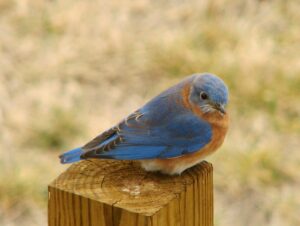
Why does New York have so many pigeons?
Rock pigeons, the original ancestors of New York City’s pigeons, are naturally suited to urban environments. Their strong feet and beaks can handle harsh surfaces and climb buildings, and their diet can adapt to human scraps and refuse.
Cities like New York offer an abundance of ledges, crevices, and sheltered spaces on buildings and bridges, mimicking the cliffs pigeons historically nested on. This provides ample breeding grounds for them to thrive.
Related Articles:
34 of the most common birds in the United States (with photos)
Feeding winter birds in New York



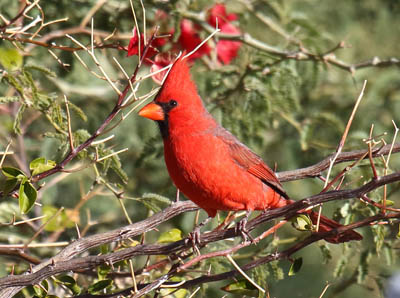
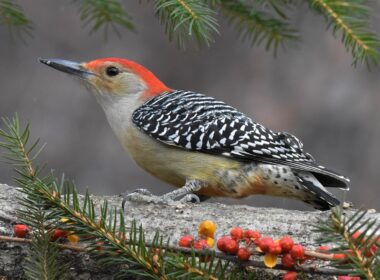
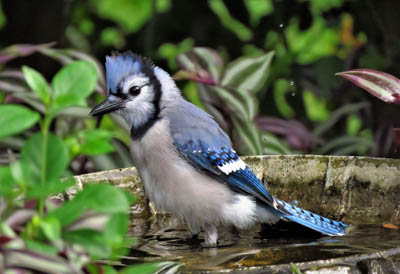
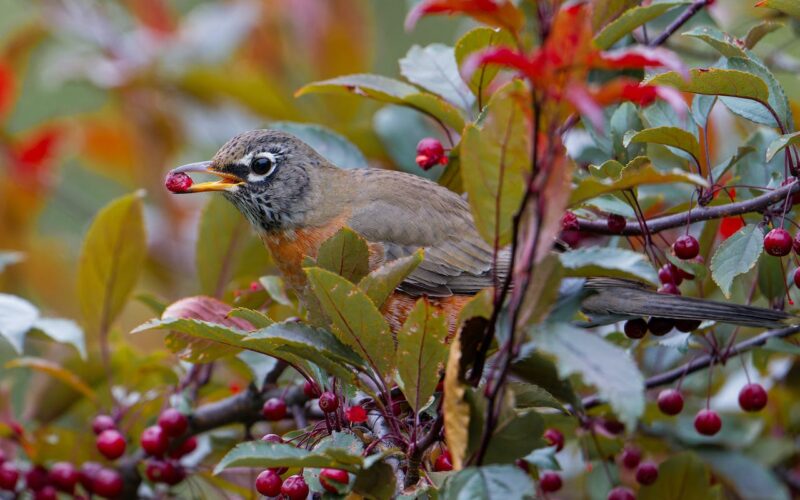
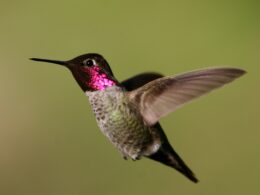
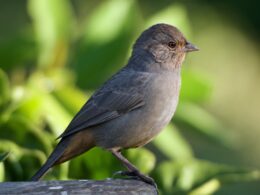
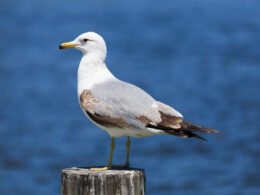
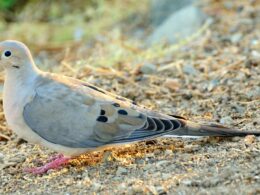
This was so incredibly helpful! Thank you for compiling all this useful information! I wish I would of found this site a few years ago when I started "seriously" backyard birding. At the time I think the only ones I could of identified were the bluejay and cardinal! I live in Suffolk county and the lists are pretty spot on. My rare bird is the northern flicker, in 3 years I've only seen one twice! Both times they were eating a fruit and nut blend from a platform feeder. They are quite a sight with their yellow wings, I wish I knew the secret to attracting (and keeping) more in my area! My most common bird is the white throated sparrow. I've got dozens of them and they're quite friendly. I was looking for a new gray bird I've seen three times this week. He's not a mocking bird or a catbird, they're frequent visitors so I feel confident of their identities. He's a smokey gray with black wings and is a little smaller than a cardinal. The hunt continues for his identity but that's one of the things I love most, seeing a new addition to your yard and learning about them! Thank you again for all this great info, I'll be back to explore more!
Sad news… new bird was in the platform feeder when I came home from work, the perfect time to study it more closely. Then comes a black headed cowbird to eat next to the new bird. I feel a sense of dread as they seem almost friendly. Next thing I know they're chasing each other through the trees and zipping all over the place. Frolicking! Yep, it's a female black headed cowbird. Oh no. I've considered myself lucky because I've only ever seen 2 males in my yard, couldn't even remember what the female looked like from my research a couple years ago. I have many 1&1/4 birdhouses but I have plenty 1&1/2 and some larger woodpecker houses that they can absolutely get into to. Ugh! But I guess they can't help what they are… :/
Ah, yes. I was going to suggest female Brown-headed Cowbird. They've just returned to my neck of the woods here in Washington State.
That's right. the birds do what they do. It is us who judge them. Back in the 1930's birds were judged by the government based on the foods they ate as "good" or "bad."
Cowbirds and then here comes the house wrens too… those wrens have already taken over half the birdhouses! I'll have to wait and see which ones are legitimate nests.
But yes, birds do what they do and it's not our place to think of them as good or bad. They all have a purpose. Makes me think of Chairman Mao and "the great leap forward". The "four pests" theory, one of many disastrous campaigns of the movement. Thinking that killing every sparrow and destroying all their nests and young would increase crop production… well they didn't factor in all the insects they feed their young! When everything was said and done, a horrible famine was the result. Maybe as many as 50 million people died. Just terrible and ludicrous thinking. Personally, I love all my various sparrows! And while I may find the habits of some birds, less than desirable, I'd never wage war on them!
Yes, House Wrens can take over nest boxes you may put out for bluebirds. Swallows. Starlings, and House Sparrows can do the same.
Still, something living is better than no birds at all.
Never seen a blue bird here in Long Island for years…lots of Robin's etc but no blue birds, they were common here years ago…also saw a big nest of Quakers.
Thanks for sharing the birds of your backyard. Yes, bluebirds are more found in rural and farm areas. I can see why Long Island might no longer provide them the habitat they need.
I've never seen the nests of Monk Parakeets myself.
I really appreciate your list of birds. Ty
You are welcome!
Thank you for this wonderful information.
I would love to see a comparison chart of all the long island sparrows. I still have difficulty deciphering them all. Thanks again!!🦋
Sparrows are tough, that's for sure. To learn them means studying and learning the feathers of the head in the introduction to the field guides.
Learn the female House Sparrows and the White-crowned Sparrows that come to your feeders. The shape of body, head, and tail on many sparrows can help (silhouette).
Glad this article was helpful to you!